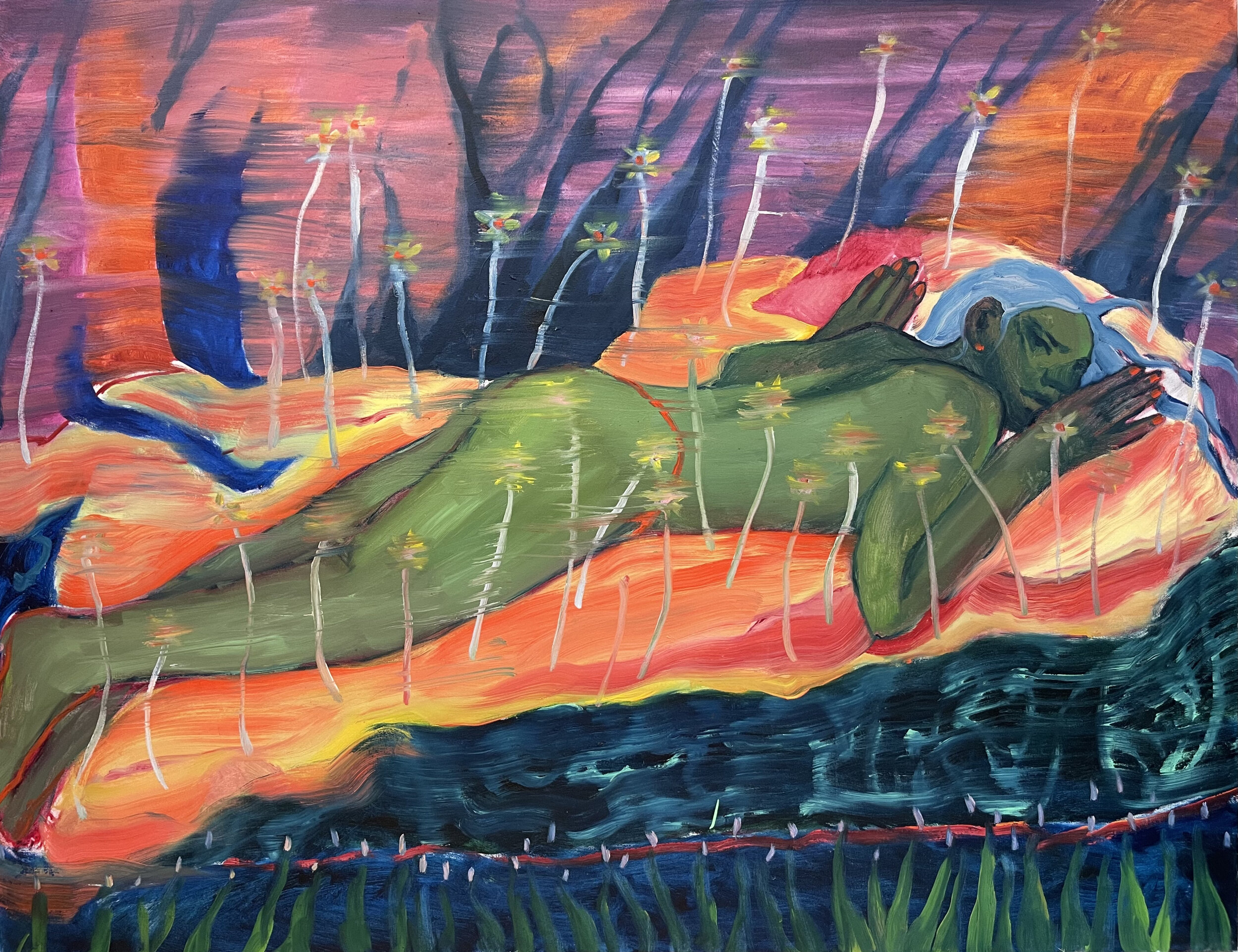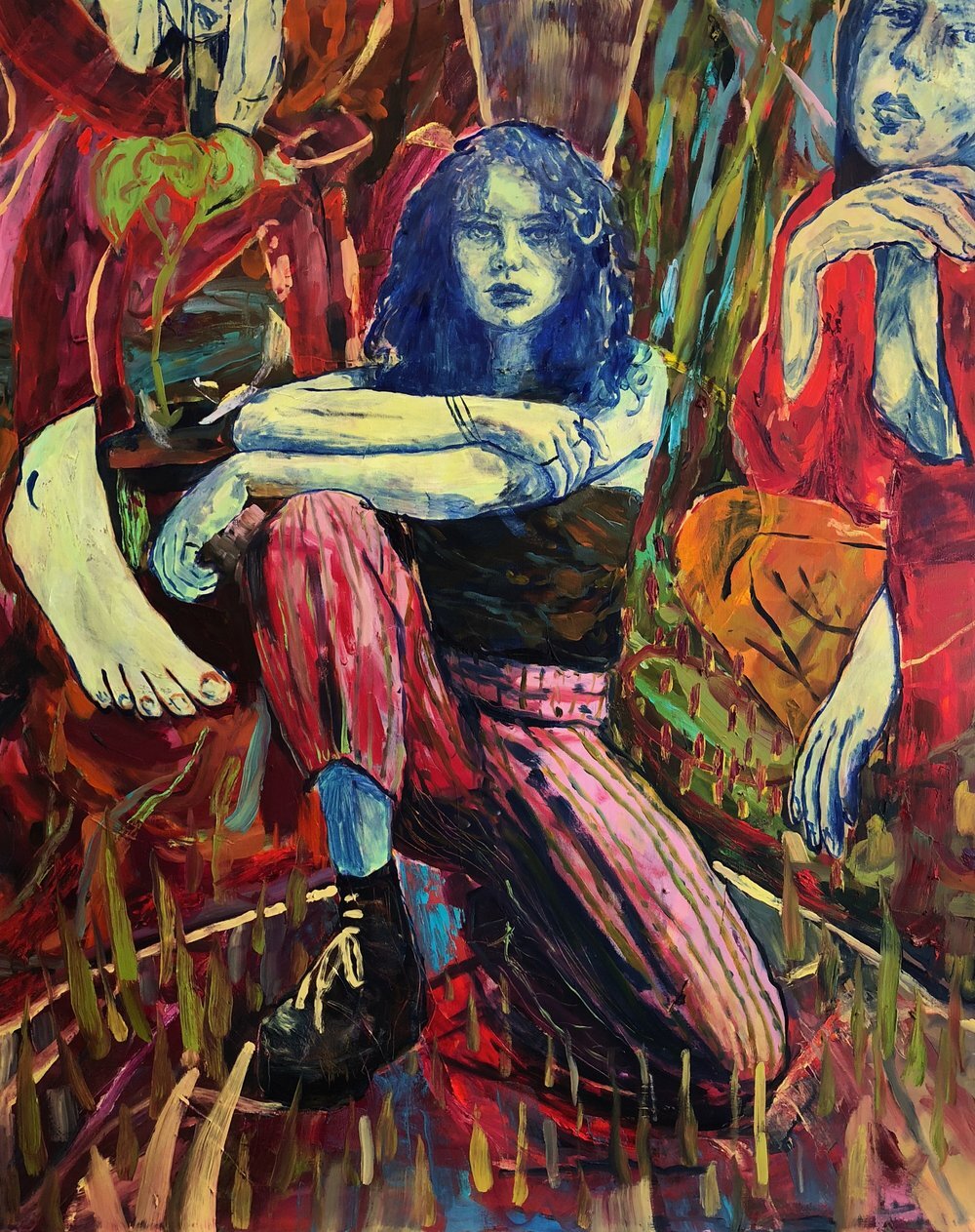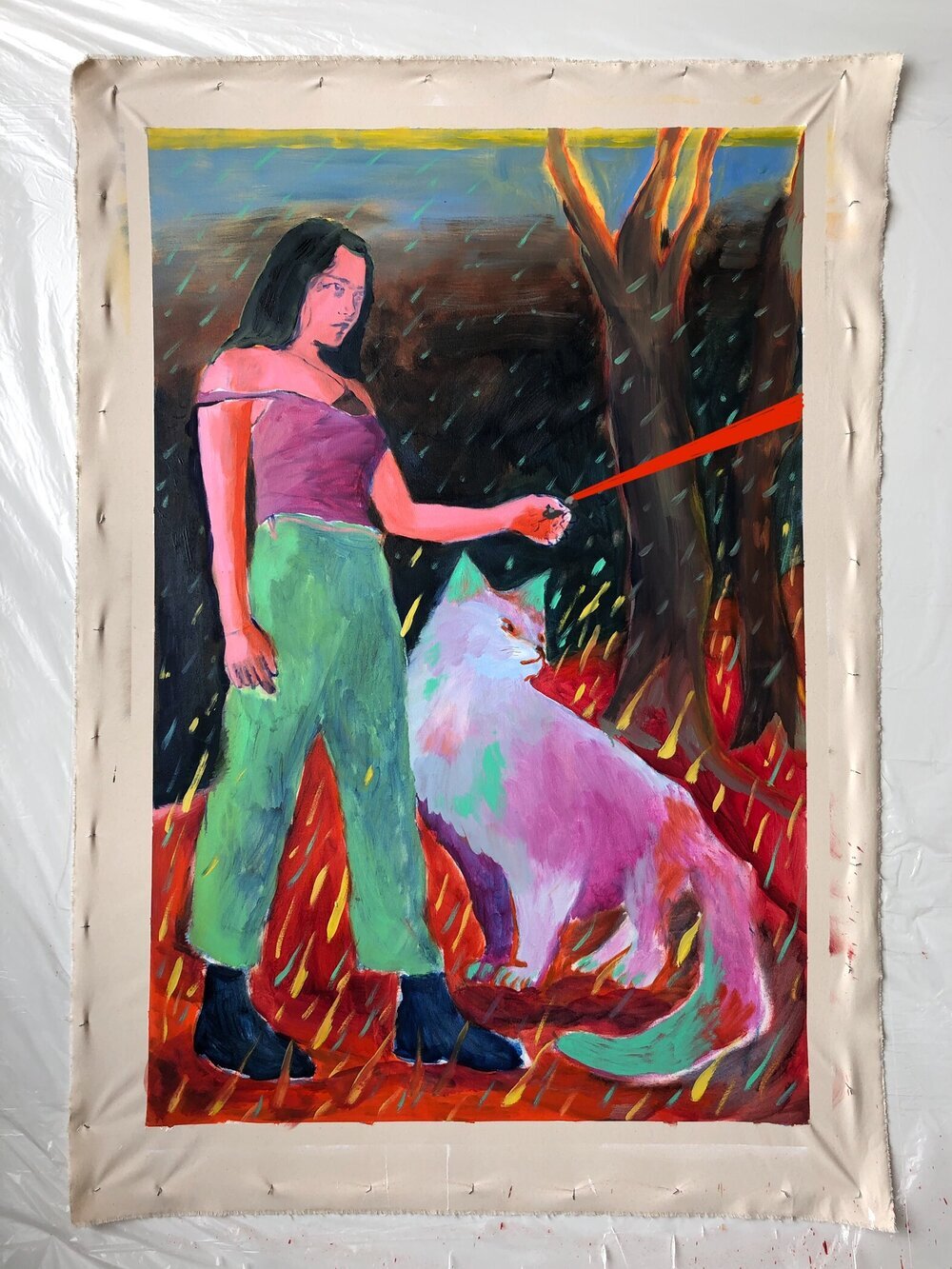
CAROLINE ABSHER
Interview published August 11, 2021
Caroline Eleanor Absher grew up in South Carolina. She moved to New York in 2012 to pursue painting. After getting an Art History degree from Pratt Institute, she settled in Brooklyn, where she has a painting and prop styling studio.
Hi Caroline! Thanks for joining me for Mint Tea. To begin, what’s your favorite tea?
I like chamomile and chai. Pretty much anything that's either spicy or calming.
Could you tell me about your background and your practice?
I grew up in the South, in South Carolina, with lots of woods, and mountains. I was always a pretty shy kid, and I found from a pretty early age, that painting was the way that I could express myself the easiest. So I would just always paint, and then I guess I just hung on to that. I do oil painting, mainly, and the reason I love oil is how it kind of has this way of staying alive for you on the surface. I paint really quickly, and a lot of times, I'm making pretty snap decisions about what's going to happen, and most of the time my paintings only take six or seven hours to finish. I couldn't do that with any other medium. Acrylic dries too fast and drawing is too slow. So I really love oil for that reason, and I picked it up, and I haven't ever really gone back.
Caroline Absher, “Search Party,” 2019, oil on canvas
Caroline Absher, “Magic Flowers,” 2021, oil on canvas, 64 × 50 in.
Installation view of “Magic Flowers” at Daniel Raphael Gallery, 2021
What projects are you working on right now?
I'm working on a new series. A couple of weeks ago, I went to the Museum of Natural History, and I was completely and totally taken. I mean, I've been there a million times before, because I've been in New York for ten years – it’s one of my favorite places to go. But for some reason, these fossils on like the fourth floor, they sort of just struck me. There's just something so beautiful about these objects that we have that are little compressed creatures that don't exist anymore, but the way that they're laid into the sand is, without them realizing it or anyone realizing that they were creating these beautiful shapes, and the rocks themselves, and the coloration in the sand, and the texture, it's already a painting. You know what I mean? So I'm trying to figure out a way to incorporate this kind of fossilization into my more figurative pieces. Also it speaks to my interest in memory and how it's kind of a self-preservation tactic for memory to only kind of hold on to the positive aspects of something traumatic that happened to you. It kind of hides or buries the really dark things, which I think is really beautiful. There's definitely a connection there, and I'm kind of working out what it is, but I'm really excited. I haven't felt this nerdy about something in a while.
I am the most familiar with your figurative oil paintings. Can you talk about how and why you choose to work with the medium that you do?
Yeah, I think that the thing with oil paint is really just what I said earlier about it staying wet for long enough, because while I'm working, I'm also making really quick decisions, and I need to be able to work back into the painting. Honestly, whenever I start something, I really don't know what it's going to become, and it's only later that I understand what I was really going for. Which, in my opinion, could only work with a kind of paint that could stay wet.
Figures, to me, this is interesting, because no one's ever really flat out asked me why. I think it's just because I love doing it.
Caroline Absher, “Spirit of the Cat Watching,” 2020, oil on canvas
What is your creative process like? Do you start a painting with a specific image in mind from the beginning or does it evolve organically as you go? How long does it usually take for you to finish a painting?
So whenever I start a painting, I do have kind of an image in my head. But I don't really do any sketches or color studies, because I find that when you think too hard about something before you do it, you kind of play yourself and back yourself into a corner, in my experience. What I do is I just tried to go in completely unencumbered. I don't know, it's a very free flowing kind of process that I have, and the consequence of it is that most paintings that I make are garbage. But I just don't show those ones. It's a lot of trial and error. But what I really love about this process, in particular, is how you kind of start a painting, and then five hours later, you've been using these symbols that keep popping up, or the figure starts to morph, and it actually ends up looking a lot like you or your friend, because it's all freehand, so I really just have no idea what is going on. And then you start adding colors, and it kind of starts forming, and it just comes to life. I know that that sounds really hokey, and way too romantic, but it's true. And I think that's why I love painting so much, because it's not this precious thing, it's something that just comes straight from whatever the heck is going on in my head that I can't really put into words, somehow it appears and it just happens.
I think the figures, they do end up looking a lot like me sometimes, because I am the person that I know the best. So when I'm painting a figure, I don't really work with male forms. I always find myself, like I have really big feet, so the feet are always really big. And I have a kind of stockier frame, so the legs and end up looking like thick, stocky, beautiful legs. And then finally, I'm getting up to the face, it's like, what is the face that I've seen the most in my life? Everyone's like, “Are those you?” No, they're not supposed to be? It's just that I am the image that I've seen the most, and I know how to express the best.
Do you ever paint other subjects for your figures? Who do you like to paint?
So I will definitely start out with an image of someone that I love. I've painted many of my friends over the years. Usually it starts out with an image of them, and then it morphs into something, and it very rarely ends up looking like the person from the reference. But it's okay because some of them have said that, for some reason, even though it looks nothing like them, they can sense something that is going on that is very similar. I'm thinking about them while I'm painting them, so there has to be a little morsel of truth there.
What is your favorite part of a human body to paint?
I would say probably the face. Just kind of the whole expression. I love big noses, and a really strong gaze, and usually they look really focused on something that's off frame and you kind of wonder what they're on about. I think the face tells most of the story in figurative art, for sure.
Caroline Absher, “Last Cigarette,” 2021, oil on canvas
Caroline Absher, "Territory," 2019, oil on canvas
Caroline Absher, 2019, oil on canvas
Caroline Absher, "Kayla," 2019, oil on canvas
Can you talk about any imagery or symbols that you like to work with? What inspires you?
Nature has always inspired me, and I've always felt very out of touch with myself when I haven't been in nature for a while. What inspires me, I think, is the kind of mystic, mythic connection that we have to all living things. I'll paint an animal, or a figure, or a tree, or something, and they all have this way of feeling like they're all the same entity. Whenever I paint an animal, it's like, the animal is the animal version of the person in that painting. Also, it's really hard to put to put what you paint into a box, sometimes. And I know that, you know, you're supposed to be able to talk about this stuff really fluidly. Because you know, it's your work. But for me, it's always been really hard to figure out the right way to express what I'm trying to say. I think, in a lot of ways, the reason why people paint is because they're not very good with words. Like, otherwise, I'd be a writer, you know what I mean? All of the things that people get from my paintings are probably what I'm trying to give them. I feel that it's very apparent.
I had this realization pretty recently that I don't necessarily agree with this idea that we have to have this like fully formed idea about our own work. I mean, if we are just a conduit for our energies and our emotions, it should make sense that we just make things and then we release that, and whatever someone else gains from it is theirs. I don't even need to talk about why I'm making it, it's just out there, and now it's someone else's, because they can look at it and maybe look at it for more than 10 seconds and gain something from it in their lives, whatever. That's really how I feel, I definitely don't take it too seriously, because as soon as you do that you kind of muddle things.
Do you think the size of the canvas that you work on affects your work?
Yes. I have always needed a large surface to work on, because I find it much easier to paint with my body than my wrist. As you go above maybe four by six, it's such an active experience, and I find that that is the best way for me to connect to my body, which is kind of the whole point.
What was it like for you to make smaller works?
It was really hard. I was asked to be in a group show for Blue Shop Cottage gallery. It was a paper work show. I guess people think that because I make paintings, I can also make small paintings, and that is simply not the case. I tried, I failed, I tried again, it was a whole emotional experience for me, because I realized that I definitely do need the size in order to paint well. It may be because it's all that I know. And of course you can train yourself to do anything, but I don't really believe that we need to train ourselves to do something that doesn't feel inherently natural at the first try. When it comes to art, do what feels the best.
Caroline Absher, "Spirit Cat II," 2019, oil on canvas
Let’s talk about fairies. What kind of fairy do you identify with? Describe her to me.
Oh my gosh, I love fairies. I think I most identify with the demon fairies of Victorian lore, because they began the idea of like a tiny winged women as a troublemaker, kind of demon seductress, mischievous figure that would distract the men and taunt them, and ultimately drive them to do horrible things such as commit murder. They would become the scapegoat for men, they would just say, “Oh, I blame it on the fairies. She came to me in a dream and told me that I should do this.” And people would literally let them get away with it. I don't know, I just I heard that, and I was like, “Damn, that is so cool.” They've been really changed, obviously, like there's Tinkerbell and stuff, and I think that the original version is so fascinating.
I love the idea that the fairies that we know and are familiar with have actually been totally transformed through storytelling over the centuries. But if I had to pick, I would definitely be a flower fairy because they wear petals as dresses, and they are really colorful and they probably have really long hair, and I'm just obsessed with them.
What are your favorite colors? Do they find their way into your artworks?
Definitely. My favorite colors are every red there is, every green there is, and every blue there is. Actually, I've been getting into this weird one. It's chartreuse. Very interesting color. It's like, acidic, greenish yellow. I usually hate yellow, but this one I'm into.
Is there a new medium or a technique that you would like to try or to work in more?
I think I want to try painting without relying so much on brushes. I want to use different tools to apply paint. Anything, like you can use a credit card, cardboard, a shoe. Like, a rag. You know what I mean? Like, literally anything.
Where are you located now? Do you think living in Brooklyn influences your practice?
So I live in Brooklyn, and definitely, the constant flow of energy that's always around me both distracts me from painting and keeps me motivated to continue painting at the same time. I love New York so much. I moved here when I just turned 18, I went to school here, and I didn't really paint as much., I mean, I painted enough to know that it's why I wanted to move to New York, but I was just kind of spending my time figuring out what it meant to be a teenager.
How do you stay connected to your community?
I would say, I really value my friendships and I love making friends. I think the most important thing is to stay connected, especially when you're feeling depressed, or lonely, or sad. And so, it's good to force yourself to reach out, especially in those times when you least want to, and that has become a practice over the past year for me. Also, social media is a really great resource for me. I've made so many friends on social media, and then we meet in real life and then become besties, and we end up traveling together. People think I'm weird for how many friends I've actually made on Instagram, like real life friends.
Caroline Absher, "Spirit Cat," 2019, oil on canvas
Caroline Absher, "Spirit of the Cat Watching," 2020, oil on canvas
Caroline Absher, "The Room that Held Us," 2020, oil on canvas
What is the space where you do your work?
What's the space? Well, I print a bunch of stuff out that I like, I tape it to the wall, and I kind of water my plants, do some organizing, stare at the blank canvas for a while, and then I just psych myself up by listening to music. Then, hopefully something happens. And if not, it's all good. Having my own studio has been life changing.
Do you have any ritual that helps you get into the zone?
Well, I guess that's what I just said. I think my ritual would be listening to emotionally triggering music. Literally, I bet a lot of people do this. Definitely I'm not the only one. Um, oh my god. I mean the most angsty years was, you know, Bon Iver, those kind of gut wrenching, instrumental, whispery voice indie guys, they mess me up. They really messed me up because I was 16 when that was popular. All it takes is 30 seconds of one of those songs, and my brain goes to this deep, subconscious land where it's really easy for me to paint.
Caroline Absher, “Rare Sighting,” 2021, oil on paper, 18 x 24in.
When do you know when you are finished with your artwork or a body of work?
Actually that's a really good question, because most of the time I don't, and then I overwork it. A lot of times it's very easy for my friends to influence final mark-making decisions. They'll come in, and they'll see it and they're like, “Oh, you should do this, you should do this.” And my dumb ass listens to them. I pick up a paintbrush, and totally mess up this moment that I was so proud of. So to answer your question, it's actually very rare that I know for sure, so a lot of times what I do is force myself to exit the room when I find a natural – resting place. Sometimes I'll call my friends – they're like my painting sponsors. I'm like, tell me not to go mess up this painting. Like, tell me a story or something?
Who are your favorite practicing artists?
So I love Ana Benaroya. She's awesome. Danica Lundy, so cool. And then Jenna Gribbon. These are all figurative. She's amazing, because she's a really fantastic colorist. One little brushstroke conveys so much information about the light in the environment. That, to me, is really impressive because it's something that I struggle with. Ana Benaroya, she's a really young, really great artist, a painter. I first saw her work in LA, and then New York, and I just really like watching her progress. She's fascinating. And then Danica Lundy, also young, awesome. Her paintings are actually insane, you could look at them for hours. I also love Doron Langberg, Lisa Yuskavage, and Cecily Brown.
What gives you the feeling of butterflies in your stomach?
I just think knowing that I'll be having a new experience soon is really important to me, and I'm constantly chasing new feelings to feel.







